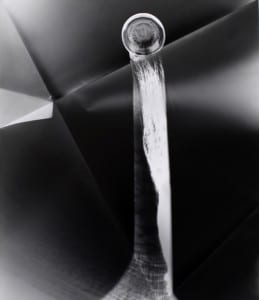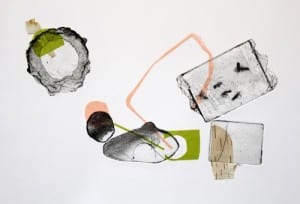Letting things draw themselves
By Jack Ashby, on 4 December 2015
This is a guest post from our artist in residence Eleanor Morgan. It is part of a series exploring the exhibition Glass Delusions at the Grant Museum of Zoology.
During my artist’s residency at the Grant Museum I wanted to record the way light travels through the glass jars and specimens that fill the space. My first thought was to try cyanotypes. This is a type of contact print in which an object is place on paper and exposed to light. Where the light hits, the resulting image is a deep blue colour. The astronomer John Herschel developed cyanotypes in the nineteenth century for creating blueprints of diagrams and notes, but it is the cyanotypes of his contemporary Anna Atkins that are particularly celebrated. By placing seaweeds and ferns on prepared paper, Atkins’ cyanotypes are beautifully detailed and create a sculptural effect on the paper.
Trying the cyanotype process in the Grant Museum was going to be difficult. To protect the specimens the windows filter out ultraviolet light, and it’s this spectrum of light that is needed to create cyanotypes. I played around with using ultraviolet light bulbs, similar to those used in sunbeds, but the results were vague. I then started exploring the possibility of making photograms. These are also contact prints, and are made by placing an object on photosensitive paper and then developing this in a darkroom. The image is black where the light has hit, and white where the paper is in shadow.
With the help of the Museum curator, we carried a box of glass sponge specimens in their glass jars over to the darkrooms at the Slade School of Fine Art. There, in the dark, I spent days playing with torches – flashing lights onto the specimens so that they left their mark on the paper. I experimented with folding the paper, so that the specimens seemed to stretch and reach around the confines of their jars. Some of the resulting prints are on display in the current Glass Delusions exhibition, and for me they allowed the specimens to draw themselves – to make their own marks and lively movements.
‘Spicule soup’ is another series of prints, some of which are on display in the Museum. These are collagraphs, which is a type of printmaking rather than photographic technique. They are formed from five different ‘plates’ – this is the name given in printmaking to the surface to which ink is applied, such as an engraved copperplate. In collagraphs, however, anything can be used as a plate. The process involves collaging together different textures to create a surface that can be printed. One of the aspects of glass sponges that interested me was the way that they grow by sticking together silica from the sand that floats around them in the deep ocean. I didn’t want to illustrate this; I wanted the printing plates to mimic a floating and sticking movement. The five plates that feature in the ‘Spicule soup’ prints are made from various bits of detritus and discarded materials. I put them on the etching press and gave them a shove, so that they bumped into each other and found their own position. Each print in this series involves the same printing plates, but they have budged and shifted each other to create new formations.
Glass Delusions is an exhibition at the Grant Museum of Zoology, it is the end result of a year-long residency by artist Eleanor Morgan. It is open until 19th December 2015.
Eleanor Morgan is Artist in Residence at the Grant Museum of Zoology, funded by the Leverhulme Trust.
 Close
Close






